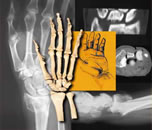


 |
|
||
Vessel Loop Closurefor cases with excessive swelling(Continued) Case Example (continued) The wound was closed with the Vessel Loop Closure:
A close-up view shows that there were two vessel loops used, with two knots:
At each dressing change, the vessel loop knots were untied, the vessel loops tightened, and re-knotted. After several dressing changes, the wound edges were approximated and closed primarily. Clinical Practice I have used this on many wounds, both on the arm and on the leg that were several cm wide, and closed them without any grafting. I have pre-placed the final closure sutures in patients who I knew I would not be able to take back to the OR, and closed the wound and removed the staples at the bedside. In one case where I was assisting another surgeon in closing a wound in which we were planning on performing a skin graft, I placed the vessel loops at the beginning of the case, then proceeded to debride the wound, etc. The skin edges were ready to be closed primarily at the ends, so this was done. By the time we got to the skin graft portion of the procedure, more of the ends were close enough to close primarily. By the end of the case, the entire wound was closed primarily, and the skin graft was not necessary. Comment This technique is quite handy to know, and is great for fasciotomies of the leg (I learned it during my vascular rotation). If you do need to place a skin graft, be sure to wait until the swelling resolves, or it is likely to be too big when the swelling does go down. Remember, skin grafts thicken and darken, and are insensate. They do not substitute for normal skin. The Vessel Loop Closure will give you normal skin, normal sensation, and normal subcutaneous fat. William "Jay" Ericson, October 31, 2007 |
|||
| About Us | Research | Basic Knowledge | What's New | Forum | Guest Professor | Post a Case | eRadius Conference | Patients | Home |